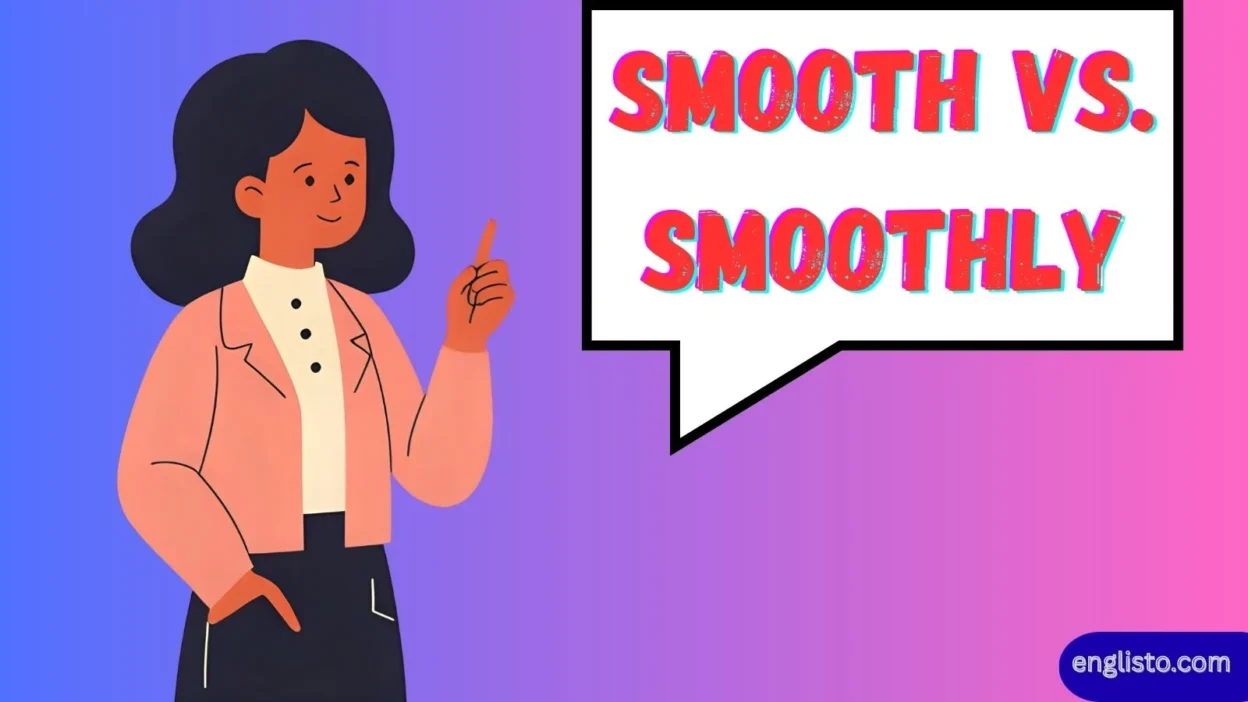Language can sometimes feel like a smooth ride—effortless, natural, and without interruption. Other times, it feels bumpy, full of friction, hesitations, and pauses. One such tricky pair in English that often causes confusion is “smooth” vs. “smoothly.” Though they look similar and are sometimes used interchangeably, they serve different roles in grammar, meaning, and context. Smooth vs Smoothly.
In this article, we’ll glide through the nuances of these two words—covering their definitions, functions, grammar rules, examples, real-life applications, and mistakes to avoid. By the end, you’ll feel confident choosing the right form for any sentence, whether you’re writing a professional article, speaking in public, or simply describing a dancer’s graceful movements.
What Does “Smooth” Mean? (Adjective and Noun Contexts)
“Smooth” is most commonly used as an adjective, describing the surface, texture, or manner of something. It conveys the absence of bumps, roughness, or irregularities—both in physical objects and abstract situations.
Key Characteristics of “Smooth” as an Adjective
- Texture and Surface: flat, sleek, polished, even.
- Performance or Action: done with ease, without jerks or pauses.
- Social or Figurative Meaning: calm, suave, composed, effortless.
Examples in Sentences:
- The marble countertop felt smooth under my fingers.
- The car engine gave a smooth ride on the highway.
- James Bond is known for his smooth demeanor in negotiations.
“Smooth” as a Noun
Less commonly, “smooth” can function as a noun in casual English, usually referring to a type of texture, surface, or even personality trait.
- “This fabric has a nice smooth to it.”
- “He’s a real smooth in social settings.”
Read More: Symbolism vs Metaphor: Untangling Two Powerful Literary Devices
What Does “Smoothly” Mean? (Adverb Contexts)
Unlike “smooth,” the word “smoothly” is an adverb—it modifies verbs, describing how an action is performed. It expresses a sense of ease, continuity, and lack of interruptions.
Characteristics of “Smoothly” as an Adverb
- Modifies verbs: shows the manner in which an action happens.
- Indicates fluidity and effortlessness.
- Often used in performance, motion, or communication contexts.
Examples in Sentences:
- The dancer transitioned smoothly across the floor.
- The presentation proceeded smoothly without technical glitches.
- The airplane landed smoothly despite strong winds.
Grammar Rules: Smooth vs. Smoothly
Here’s where learners often stumble. “Smooth” and “smoothly” can’t always replace each other. Their correct use depends on whether you’re describing a noun or a verb.
| Word | Part of Speech | Function | Examples |
| Smooth | Adjective / Noun | Describes a noun (object, person, surface, trait) | “A smooth surface,” “a smooth negotiation” |
| Smoothly | Adverb | Modifies a verb (action, manner of doing something) | “She danced smoothly,” “The project ran smoothly” |
Quick Tip: If you’re describing what something is like, use smooth. If you’re describing how something is done, use smoothly.
Real-Life Usage Examples
To better grasp the difference, let’s look at how both words appear in everyday life.
In Driving & Transportation
- Correct: “The car has a smooth ride.”
- Correct: “The train arrived smoothly at the station.”
- Incorrect: “The car runs smooth.” (should be “smoothly”)
In Dance & Music
- The jazz musician’s saxophone played a smooth melody.
- The dancer glided smoothly across the stage.
In Business & Negotiations
- The meeting went smoothly, with all parties reaching an agreement.
- The CEO has a smooth way of handling complaints.
The Importance of Context and Precision
Using the wrong form can cause confusion, especially in formal writing, business communication, or academic work. Misusing “smooth” for “smoothly” (or vice versa) makes your English sound unclear or careless.
Why Context Matters:
- “Smooth” is descriptive.
- “Smoothly” is functional.
- Interchanging them may distort meaning.
For example:
- “The elevator doors closed smooth.” (Incorrect → should be smoothly because “closed” is an action.)
- “The elevator has a smooth design.” (Correct → describing appearance.)
Synonyms and Substitutes
Both words have rich synonyms depending on their usage.
| Smooth (Adjective) | Smoothly (Adverb) |
| Sleek, polished, even, flat, silky, effortless, graceful | Seamlessly, fluidly, steadily, effortlessly, naturally, uninterruptedly |
Idiomatic and Figurative Uses
English often uses “smooth” figuratively to describe people, conversations, or events.
- “Smooth operator” → Someone charming or persuasive.
- “Smooth sailing” → A process without obstacles or complications.
- “Go smoothly” → A situation proceeds without disruption.
Example:
“After weeks of planning, the wedding ceremony went smoothly—without delays or mistakes.”
Common Mistakes and Misuses
Many native speakers casually interchange the two words, especially in speech. However, in writing, correctness is important.
Frequent Errors:
- “He spoke smooth.” (Wrong → should be smoothly.)
- “The cake batter mixed smoothly.” (Wrong → batter is a thing, so use smooth.)
Corrected:
- “He spoke smoothly.”
- “The cake batter is smooth.”
When to Choose “Smooth” vs. “Smoothly”
Here’s a quick decision guide:
| Question | If Yes → Use Smooth | If Yes → Use Smoothly |
| Am I describing a surface, object, or quality? | ✅ | ❌ |
| Am I describing how an action is performed? | ❌ | ✅ |
| Does the word come before a noun? | ✅ | ❌ |
| Does the word come after a verb? | ❌ | ✅ |
Enhancing Writing with Smooth / Smoothly
Good writers proofread to ensure precision in word choice. Choosing the right form improves clarity, style, and effectiveness.
Tips for Mastery:
- Always identify the word you’re modifying (noun vs. verb).
- Avoid casual habits where grammar slips into informal speech.
- Practice rewriting sentences with both forms.
Practice Example:
- “The customer service representative handled the complaint ___.”
- Answer: smoothly (action → handled).
FAQs about Smooth vs. Smoothly
Q1: Can “smooth” ever be used as an adverb?
No. In modern standard English, “smooth” is not used as an adverb. The correct adverbial form is “smoothly.”
Q2: Why do people often say “go smooth” in casual speech?
It’s informal and grammatically incorrect. Native speakers sometimes drop “-ly” in casual talk, but in writing, always use “smoothly.”
Q3: Is “smooth” more common in describing people than “smoothly”?
Yes. “Smooth” often describes personality, behavior, or appearance, while “smoothly” is tied to actions or processes.
Q4: Which is correct: “The meeting went smooth” or “The meeting went smoothly”?
Correct: “The meeting went smoothly.”
Q5: Can I use both words in the same sentence?
Absolutely. Example: “The smooth surface of the dance floor allowed her to glide smoothly across it.”
Conclusion
Mastering the distinction between smooth and smoothly is like learning to glide across a dance floor: once you get the rhythm, it becomes natural.
- Smooth = adjective (describes nouns).
- Smoothly = adverb (describes verbs).
Using them properly adds clarity, precision, and elegance to your speech and writing. Whether you’re talking about a car engine, a dancer’s movements, a business negotiation, or even a silky piece of fabric, choosing the right word ensures your ideas flow without interruptions—smoothly, every time.



